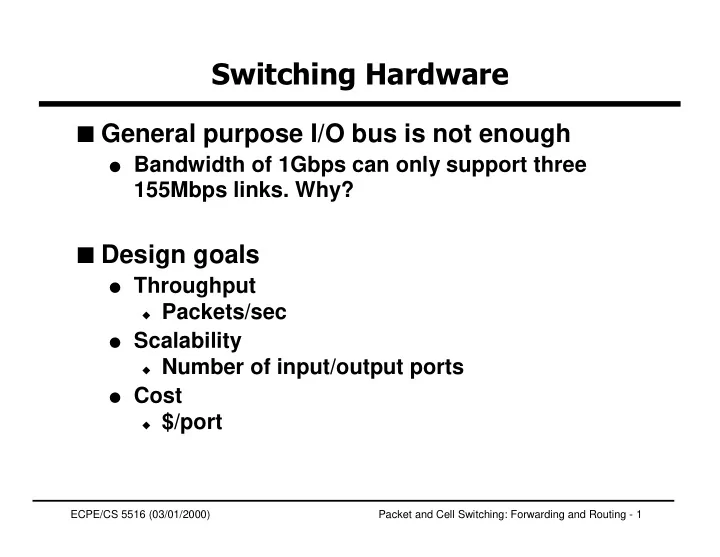

������������������ ■ General purpose I/O bus is not enough ● Bandwidth of 1Gbps can only support three 155Mbps links. Why? ■ Design goals ● Throughput ◆ Packets/sec ● Scalability ◆ Number of input/output ports ● Cost ◆ $/port ECPE/CS 5516 (03/01/2000) Packet and Cell Switching: Forwarding and Routing - 1
���������� ■ Can be defined in terms of Total bandwidth: ATM networks ● Forwarding rate in packets/sec: Switched Ethernet ● ■ Throughput is a function of traffic Need to model traffic accurately ● ■ Traffic modeling parameters Packet arrival time ● Destination distribution ● Packet size distribution ● ECPE/CS 5516 (03/01/2000) Packet and Cell Switching: Forwarding and Routing - 2
����������� ■ Cost is a function of number of I/O ports (n) ■ Scalability can be thought of as the rise in cost with increasing n. ■ Switch designs also have hardware limitations when the number of ports becomes very large ECPE/CS 5516 (03/01/2000) Packet and Cell Switching: Forwarding and Routing - 3
����������������� Input Output port port Output Input port port Switching Fabric Output Input port port Output Input port port ECPE/CS 5516 (03/01/2000) Packet and Cell Switching: Forwarding and Routing - 4
����������������� ■ Ports communicate with the outside world Optoelectronics ● ■ Ports also support the routing model. E.g for VC model, ports manage connection ● setup/routing/teardown ■ Fabrics are fast bit pushers. They take data from the input port and move it to an output port. ■ Complexity of determining the output port for a packet is handled by the input ports. ■ Such fabrics are called self-routing ECPE/CS 5516 (03/01/2000) Packet and Cell Switching: Forwarding and Routing - 5
����������������� ■ Performance bottlenecks Input port: header analysis, routing table lookup ● ■ Buffering can occur at the Input port ● Fabric ● Output port ● ■ Design and implementation of buffers have the greatest impact on performance ■ Simple scheme: Input buffering with FIFO queue ● Drawback: head of line blocking. Max. throughput 59% ● ■ Buffering discipline determines QoS ECPE/CS 5516 (03/01/2000) Packet and Cell Switching: Forwarding and Routing - 6
����������������� ■ Every input is connected to every output. ■ Can handle data arriving at all n inputs simultaneously ECPE/CS 5516 (03/01/2000) Packet and Cell Switching: Forwarding and Routing - 7
����������������� ■ Speed of the output buffer has to be proportional to n ■ Complexity of the switch fabric grows as n 2 ECPE/CS 5516 (03/01/2000) Packet and Cell Switching: Forwarding and Routing - 8
��������������� ■ Assumption: ● Not all input ports need to get to the same output port simultaneously ■ The design supports no more than L inputs out of n to proceed to the output ■ Note: ● Choice of L is hard. Servers on an output port can ruin the above assumption ECPE/CS 5516 (03/01/2000) Packet and Cell Switching: Forwarding and Routing - 9
��������������� ■ Knockout has 3 components ● A set of packet filters that determine the inputs destined for the current output ● A set of knockout concentrators. Each concentrator has n inputs and L outputs. Given n inputs destined for the same output, it selects L out of them fairly . The remaining n – L inputs are discarded ◆ Fairness implies that no input gets dropped more or less than any other ● A per output buffer that can accept L inputs at a time. ECPE/CS 5516 (03/01/2000) Packet and Cell Switching: Forwarding and Routing - 10
���������������������������� Inputs ■ Uses a tennis tournament style knockout system. ■ You play division I first, if you lose, you go to D D D D division II, if you lose again you go to division III D D and so on till L D D D ■ If you lose in division L, D D you’re kicked out. D D D 1 2 3 4 Outputs ECPE/CS 5516 (03/01/2000) Packet and Cell Switching: Forwarding and Routing - 11
����������������������������� ■ Simple option: Shifter Speed of output buffer is L * link ● (a) speed. Buffers ■ Problem: requires very fast buffers Shifter (b) Buffers ■ Knockout uses a clever round robin buffering scheme with L parallel buffers and a shifter. Shifter ■ The fabric writes data to L (c) Buffers buffers simultaneously. The output port reads from one ECPE/CS 5516 (03/01/2000) Packet and Cell Switching: Forwarding and Routing - 12
�������������������������� ■ Number of packet filters = n ■ Size of output buffer/port = L ■ Complexity of concentrator/output port: n * L. This is proportional to n ● Total cost of concentrators = n 2 ■ Total complexity is proportional to n 2 ECPE/CS 5516 (03/01/2000) Packet and Cell Switching: Forwarding and Routing - 13
��������������������� Inputs Outputs … … Mux Buffer memory Demux Write Read control control ■ Used a high speed bus to transfer data between input port and shared memory. ■ Output port reads data from shared memory. ECPE/CS 5516 (03/01/2000) Packet and Cell Switching: Forwarding and Routing - 14
���������������������� ■ Offer better resource utilization through statistical multiplexing ■ Disadvantage: ● The speed of the buses between the MUX and memory and DEMUX and memory has to scale linearly with number of inputs. This restricts the use of this design ■ Shared memory switches are commercially very common. ECPE/CS 5516 (03/01/2000) Packet and Cell Switching: Forwarding and Routing - 15
Recommend
More recommend